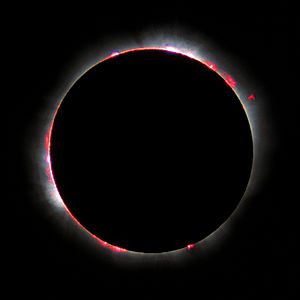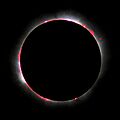Chromosphere facts for kids
The chromosphere is like a colorful middle layer of a star's atmosphere. It sits above the bright photosphere and below the super-hot corona. While we often talk about the Sun's chromosphere, other stars have them too!
On our Sun, the chromosphere is about 3,000 to 5,000 kilometers (1,860 to 3,100 miles) thick. That's just a tiny bit more than 1% of the Sun's total size! From this layer, thin, hair-like jets of hot gas, called spicules, shoot upwards. These spicules can reach as high as 10,000 kilometers (6,200 miles) into the corona.
The chromosphere has a special red color. This color comes from the light it gives off, especially a type of light called Hα. Scientists learn about the chromosphere by studying this light.
Other stars also have chromospheres. On very large stars, the chromosphere can be a huge part of the star. For example, the chromosphere of the giant star Antares is about 2.5 times thicker than the star's own radius!
Contents
What is the Chromosphere Like?

The Sun's chromosphere is very thin. Its density drops a lot as you move away from the Sun's center. It's about 10 million times less dense at its outer edge than at its inner edge.
The temperature in the chromosphere is interesting. It starts at about 6,000 Kelvin (K) at the bottom. Then it gets cooler, reaching a low of about 3,800 K. But after that, it heats up very quickly to over 35,000 K at its top edge, where it meets the transition layer and the corona.
The chromosphere is much less dense than the photosphere below it. It's also way less dense than Earth's air at sea level. Because it's so thin, we usually can't see it. The bright photosphere usually outshines it.
But during a total eclipse, when the Moon blocks the bright photosphere, you can see the chromosphere! It appears as a beautiful reddish or pinkish glow around the Sun.
Why is the Chromosphere Red?
The light from the chromosphere is mostly made of bright lines. One of the strongest lines is called Hα. This light comes from hydrogen atoms. When an electron in a hydrogen atom moves from one energy level to another, it releases this specific light.
The Hα light has a wavelength of 656.3 nanometers. This wavelength is in the red part of the light spectrum. That's why the chromosphere looks red!
What Can We See in the Chromosphere?
Many amazing things happen in the chromosphere.
Bright Spots Called Plage
Sometimes, you can see very bright areas in the chromosphere. These bright spots are called plage. They are often found where there is a lot of magnetic activity on the Sun.
Shooting Spicules
The most common features you'll see in the solar chromosphere are spicules. These are like tall, thin jets of hot gas. They shoot up from the chromosphere and then fall back down. This whole process takes about 10 minutes.
Wobbling and Waves
Scientists have found that the chromosphere is always moving. It has regular wobbles or oscillations. These movements are like waves of energy traveling through the hot gas. They can happen every few minutes.
Plasma Loops
You can also see loops of hot gas, called plasma loops, at the edge of the Sun's disk in the chromosphere. These loops are different from solar prominences. They are cooler, usually around 100,000 Kelvin. They can appear and disappear very quickly, sometimes in less than an hour! They can also expand rapidly in just 10 to 20 minutes.
The Chromospheric Network
When we look at images of the chromosphere, we see bright cell-like patterns. These are called the network. The darker areas around them are called the internetwork. They look a bit like the granules you see on the photosphere, which are caused by heat moving around.
Chromospheres on Other Stars
Almost all stars that give off light, except for white dwarfs, have chromospheres. They are easiest to see and are most active on smaller stars, like our Sun, and on giant and subgiant stars.
Scientists use a special measurement called the Mount Wilson S-index to check how active a star's chromosphere is.
Images for kids





